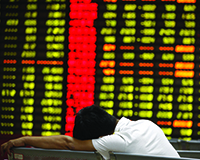
It is not only the real estate market in Istanbul being rocked by global uncertainty. Whether economic or political, volatility is impacting on property worldwide. But the opportunities are still there for the savvy investor. Emily Wright reports
The global property markets are shifting once again. Those that would have been classified as investment hotspots 18 months ago are now on considerably shakier ground. Others that looked in dire straits as recently as last Christmas have seen a huge influx of funds and look to be back on track.
But who knows for how long? The full impact of China’s slowdown has yet to become clear; no one can guarantee when oil prices will start to recover properly; and external factors such as intensifying geopolitical issues are impossible to control or predict.
To be clear, this is by no means the story of a world in crisis. Not only can slowing and stabilising markets be a much safer, more secure environment in which to invest, but there are plenty of global cities – particularly in the US and western Europe – that are still on a solid upward trajectory.
But if the past few months have taught us anything, it is that everything can change in the blink of an eye.
The world is full of markets at different stages in their property cycles. Some, like Turkey, Ukraine and Russia, are also contending with non-economic challenges, such as geopolitical instability. And in Greece’s case, there is the threat of a complete change in the country’s global status lurking, spectre-like, in the background.
So where should savvy investors be looking to get in ahead of the curve? And how can they mitigate risk in a rapidly fluctuating market?
Stabilising and rebalancing
Much of the uncertainty around global markets in the past two years – and particularly over the past few months in the Asia Pacific region – has been down to a slowing, and hopefully stabilising, of previously overheated markets.
In August, the Chinese government cut interest rates for the fifth time since November 2014 and devalued the yuan by a further 3% to stimulate the economy. The country’s plummeting stocks prompted a flurry of comments, predictions and analysis on what this could all mean for the future of the global economy at large.
But in terms of what it means for property, particularly in safe-haven markets outside the Asia Pacific region, it is not necessarily bad news.
“The Asian markets got extremely hot,” says Richard Divall, head of EMEA cross-border capital markets at Colliers International. “And the Chinese government has been actively bringing in cooling measures. But property markets are very dependent on interest rates and we were getting to the stage where the US and the UK were looking at raising them a bit.
“I think what has happened with the Chinese stock market has deferred that by six to nine months. And so real estate will continue to be a very attractive asset class as stocks are so low.”
Andrew Hawkins, director of Capital Markets at JLL, adds: “Asian cities seeing falls in value means that there is a greater need for them to invest their capital in the world’s winning cities.”
This move towards a rebalancing – albeit a small one – of global economies is likely to see more Asia Pacific funds flowing towards safe-haven cities including New York, Washington, Boston and London.
“And San Francisco,” adds Hawkins. “I don’t think people fully understand just how much of the growth we have seen globally over the past five to seven years has been down to the tech sector rather than financial services and business.”
Protection plans
As for other opportunity areas in fluctuating markets, it is all about catching the growth. And Colliers’ Divall singles out Europe as one of the best markets to be looking into at the moment. While the US could be nearing a peak in the current cycle, Asia looks set for more instability and Australia is preparing for a drop in growth, Divall says Europe is just at the right stage – as long as investors pick their markets carefully. “It is definitely the most attractive option in my mind. There is still a level of distress in some areas mixed in with solid safe havens. Italy is gathering momentum fast, and resi and logistics in the Netherlands look very solid.
“I think the rapid fluctuation across global markets we have seen recently will continue for some time, so it is key to pick the markets that are at the start of their growth trajectory to be on the right side of the rebalance.”
In terms of mitigating risk, following mega trends is one way to add protection. Patterns such as urbanisation and ageing population are two examples of global trends unlikely to be pushed off track.
George W Bush’s former economic adviser Pippa Malmgren – who now advises international investors where to spend – says avoiding glamour is another good way to protect yourself in a volatile market. “Avoid sexy, exciting assets,” she says. “Go for the boring stock that has a genuine, long-term demand.
“Sheds by an airport? We need those. Glitzy tall buildings for wealthy occupiers? Not so much. Those types of assets are very market-dependent.”
External risks
One of the biggest risks affecting global real estate beyond fluctuating economies is political instability. This has intensified over the past 12 months in markets such as Turkey, Ukraine and Russia.
Kerim Cin, managing partner at Colliers Turkey, says: “The issues here with the government and the rise of ISIS-related activity has definitely impacted on interest from overseas investors. People have got very nervous and some major investors have stepped back.”
“Political uncertainty does have an impact,” adds Divall. “And that is another reason we are seeing overcrowding into very safe-haven markets like Paris and London. You might want to stick a load of money in Bucharest. Fine. But if Putin starts world war three or ISIS continues to do what it is doing and the world goes upside down, then you want your money to be in a safe, liquid market so you can sell it.”
“We should not underestimate the attraction of political stability in cities like London,” adds Hawkins. “But, equally, we can’t afford to be complacent. Everywhere faces the risk of terrorism. But you can’t base an investment strategy around terrorist threats, can you?”
High-return options
External risk aside, as the world’s global economies continue to shift, it gets harder to select high-return investment options, not least because increasing uncertainty is likely to see overcrowding in safe-haven markets as everyone clamours for the same assets in similar locations.
While so much has changed over the past 18 months in specific regions, cities, geographies and continents, the overreaching issue is what it always has been. Markets will fluctuate and, ultimately, no one can guarantee which will be the future winners and losers.
Of course, the best protection plan is for investors to work well within their risk tolerance, to invest only what they can afford to lose and to ensure they are covered for the worst-case scenario. Whether they will or not is a different question. Years of history repeating suggests it is unlikely.
“We always have to make our own mistakes,” says Malmgren. “It’s like falling in love. You don’t know how much it hurts when it goes wrong until it happens. Even then, you forget and do it all over again. It’s human nature.”
emily.wright@estatesgazette.con
Investing in distress

How do you invest in a distressed market successfully? The key indicator we look for is on a macro level. Put simply, it is the cost of debt capital available to a developer or investor versus the normal rate of growth in the market. Because when cost of capital is high relative to growth rates, this usually means asset prices need to go down to reflect the new reality.
his looks to be the case at the moment in a number of emerging markets and peripheral European economies.
The best time to invest in a market is after a major systemic event, such as a sovereign default, when all lenders turn away en masse. For example, we have been very active in the US in the wake of the 2008 debt crisis. We made our first acquisition back in 2009.
What you need to avoid are assets that look cheap because they are cheap for a reason. Here is a simple example: suppose you see an empty office in the middle of nowhere that somebody built with a lot of debt during the previous bubble. It may be very cheap, well below replacement cost, but this does not mean it is attractive. Perhaps it should have never been built in the first place.
Instead, when looking for distressed opportunities, we always identify solid assets in good locations that are mispriced because of their ownership. Sometimes owners have to sell assets in a hurry for internal reasons or simply because they lack the human or financial resources to add any further value. We call these “orphan assets”.
Value in volatility?
We were previously very active in emerging markets in the former Soviet Union and South East Asia. At the moment, we are not convinced that emerging markets are necessarily a good place to be. Many of them are suffering from systemic issues, such as large private sector debt and slowing growth.
When you look at specific economies, you find difficult realities, such as decreasing productivity gains (China), poor governance (Brazil), or falling commodity prices (Russia and the Middle East). For these reasons, we feel emerging market asset prices and currency values may fall further as investor capital flows out of risky assets.
One can never draw exact parallels, but in some ways we see the world entering a period similar to the one it experienced between 1995 and 1999. Then, the Anglo Saxon economies were recovering from the recession of 1987-1992. By the mid-1990s, western economies were growing steadily, with little private debt and rising productivity gains brought on by the first internet revolution.
This was positive for real estate, technology and other developed-world assets. At the same time, many emerging markets were suffering from structural problems, resulting in economic “accidents” and outright defaults.
In 1994, just as I began my career as an investment analyst, Mexico experienced a major currency devaluation, known as the “tequila crisis”. In 2014, Russia had a major rouble devaluation. I have yet to see anyone refer to it as the “vodka crisis”, but the hangover is just as painful for the locals.
In 1995, several Latin American countries, such as Argentina and Brazil, flirted with sovereign default. This year saw the onslaught of the Greek debt crisis, Ukraine officially went into sovereign debt restructuring, and Puerto Rico will most likely follow soon.
In 1996, the Turkish lira appeared in the Guinness Book of Records as “the world’s cheapest currency”. Compare this with the emerging market currency drops seen this summer.
In 1997, we saw the Asian crisis that was set off by Thailand’s default and culminated in a full-blown Russian crisis in 1998. We have not seen any formal sovereign defaults in this cycle, but we wouldn’t rule this out going forward and we certainly expect more debt haircuts and rising volatility in the next couple of years. Structural problems and weak balance sheets will be further exposed by the strong dollar and the inexorable interest rates lift-off.
In short, now may not be the best time to invest in emerging markets and risky assets in general.
Protection plan
But what if you have already invested? What can be done to protect existing assets in falling markets and how do you work out whether your funds are tied up in a good or a bad asset in a distressed market?
There is no universal answer. A lot depends on liquidity and cash flow. An overseas open-ended opportunistic fund will have liquidity constraints and decision-making processes that are very different from a local industrial family that is committed to the market and may take a multi-generational view.
I often say that everything begins with strategy and ends with management. First, you must decide whether the market or the asset is strategic to your mandate and if you are prepared to go the distance. If the answer is yes, then you must focus on your team. The stronger your local management team is, the better it will be able to protect value in a difficult market and later identify attractive new opportunities when everyone else is running for the exits.
However, if the asset is not strategic, it may be better to wind up the portfolio quickly and focus elsewhere. Run an auction, sell to the best available bidder and move on. The worst decision is to adopt a half-hearted “wait-and-see” approach in a falling market without a strong team in place.











